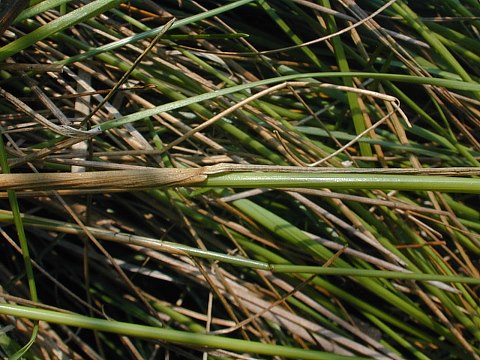Description: This perennial rush is ¾-2½' tall and unbranched, except where the inflorescence occurs. Most plants have erect or ascending stems that are stiff and straight. The central stem of each plant is light green, glabrous, and terete (round in cross-section). At the base of the stem, there are 1-2 basal leaves. The blades of these leaves are up to 12" long and 1 mm. across; they are medium green, flat, and glabrous. The blades are often recurved and rather inconspicuous; sometimes their margins are upturned. The glabrous open sheath of each basal leaf enfolds the stem at its base for several inches; it is initially light green, but later becomes light brown or tan, persisting into the fall. At the apex of each sheath, there is a pair of auriculate (ear-like) lobes less than 0.5 mm. long. These lobes have a thick cartilaginous texture and they are persistent.

Each stem
terminates in a branched inflorescence consisting of 6-60 flowers. This
inflorescence can be either compact or somewhat loose. At the base of
each inflorescence, there are 1-3 bracts that resemble narrow leaf
blades. At least one of these bracts extends beyond the inflorescence.
The umbel-like rays (small branches) of each inflorescence originate
from the same point; they are erect or ascending and variable in
length. These rays subdivide, terminating in small greenish flowers
less than ¼" across. Each flower consists of 6 tepals, 6 stamens, and a
pistil with a single style. At maturity, the tepals are 4-5 mm. long,
lanceolate, and membranous along their margins. The tepals are
persistent, eventually becoming tan or light brown. The flowers are
cross-pollinated by the wind during the summer. The seed capsules are
3-4 mm. long and ovoid in shape;
they become brown to reddish brown at maturity. Each capsule eventually
splits open into 3 parts to release numerous tiny seeds. These seeds
are small enough to float on water or blow about in the wind.
Individual seeds are about 0.5 mm. long and ellipsoid in shape. The
root system is fibrous and rhizomatous. This rush can develop densely
tufted plants from its short rhizomes; it also forms larger vegetative
colonies that are more dispersed.
Cultivation:
The preference is full sun and wet to moist conditions. Different kinds
of soil are tolerated, including those that contain loam, clay-loam,
and gravel. Sometimes this rush can spread aggressively. It tolerates
wet periods with standing water and dry periods when ground water
disappears.
Range & Habitat:
The native Dudley's Rush has been found throughout Illinois, where it
is
occasional to locally common. Habitats include wet prairies, prairie
swales, fens, gravelly seeps, calcareous springs, and ditches. This
rush is found in both degraded and higher quality habitats.
Faunal Associations:
Various insects feed on rushes (Juncus spp.),
including Dudley's Rush. These species include the billbugs Sphenophorus
callosus and Sphenophorus destructor, the
leaf beetle Plateumaris pusilla, the seed bugs Cymodema
breviceps and Cymus angustatus, the
leafhopper Macrosteles
potoria, larvae of the sawfly Eutomostethus
luteiventris,
and larvae of such moths as Capsula subflava
(Subflava
Sedge Borer Moth), Bactra
verutana (Javelin Moth), and Chilo forbesellus.
The seeds and/or seed capsules are eaten to a minor
extent by vertebrate animals (mostly small rodents, some dabbling
ducks, and rails). These species include the White-Footed Mouse, Deer
Mouse, Green-Winged Teal, Northern Pintail, King Rail, Sora Rail, and
Virginia Rail. Muskrats occasionally eat the rhizomes and crowns of
rushes.
Photographic Location:
A prairie swale at Meadowbrook Park in Urbana, Illinois.

Comments: Until about 1900, Dudley's Rush was regarded as a variety of the common Path Rush (Juncus tenuis). It is now considered to be a distinct species. Dudley's Rush is slightly larger in size than the Path Rush; it is very similar in appearance and size to the Inland Rush (Juncus interior). These three species can be distinguished from each other by structural differences in their sheaths. For Dudley's Rush, the apex of its sheaths has a pair of rounded lobes (less than 0.5 mm.) that are thickened, cartilaginous, and persistent. In contrast, the Path Rush and Inland Rush have membranous lobes at the apex of their sheaths that are more fragile and prone to breakage. The Path Rush has sharply pointed lobes that exceed 1.0 mm. in length (assuming they are not shredded), while the lobes of the Inland Rush are about the same shape and size as those of Dudley's Rush.